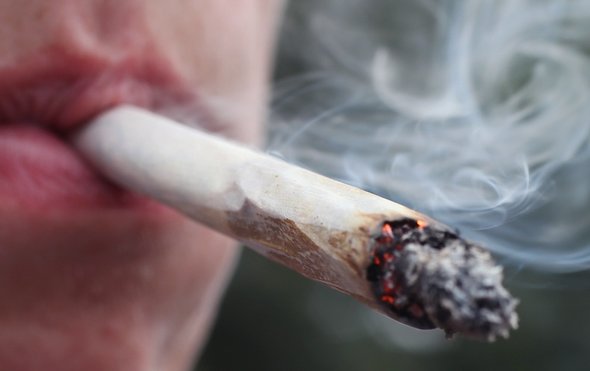By R. Douglas Fields
BERLIN—Society’s embrace of cannabis to treat nausea, pain and other conditions proceeds apace with the drive to legalize the plant for recreational use. Pot’s seemingly innocuous side effects have helped clear a path toward making it a legal cash crop, with all of the marketing glitz brought to other consumer products. But that clean bill of health only goes so far. Marijuana’s potentially detrimental impact on the developing brains of adolescents remains a key focus of research—particularly because of the possibility teenage users could go on to face a higher risk of psychosis.
New findings may fuel those worries. At the World Psychiatric Association’s World Congress in Berlin on October 9, Hannelore Ehrenreich of the Max Planck Institute of Experimental Medicine presented results of a study of 1,200 people with schizophrenia. The investigation analyzed a wide range of genetic and environmental risk factors for developing the debilitating mental illness. The results—being submitted for publication—show people who had consumed cannabis before age 18 developed schizophrenia approximately 10 years earlier than others. The higher the frequency of use, the data indicated, the earlier the age of schizophrenia onset. In her study neither alcohol use nor genetics predicted an earlier time of inception, but pot did. “Cannabis use during puberty is a major risk factor for schizophrenia,” Ehrenreich says.
Other studies, although not all, support the thrust of Ehrenreich’s findings. “There is no doubt,” concludes Robin Murray, a professor of psychiatry at King’s College London, that cannabis use in young people increases the risk of developing schizophrenia as an adult. Speaking at the Berlin conference, Murray—one of the first scientists to research pot’s link to the disorder—cited 10 studies that found a significant risk of young cannabis users developing psychosis. He also mentioned three other studies that identified a clear trend but had a sample size that was too small to reach statistical significance. “The more [cannabis] you take—and the higher the potency—the greater the risk,” he contends, warning this makes the increasingly potent new strains of marijuana especially concerning.
In an interview Murray said his research with users in London has shown that high-potency cannabis—approximately 16 percent THC (tetrahydrocannabinol)—was involved in 24 percent of all cases of a first episode of psychosis. (New laws permitting recreational pot use do not make it legal for teens to consume cannabis, but that has not impeded access.)
Interpretations of these new findings are hardly likely to receive universal acceptance. Questions about the cannabis–psychosis link have persisted for years. “The available data on this subject is far from definitive—particularly with regard to any potential cause-and-effect relationship,” notes Paul Armentano, deputy director of NORML, a U.S. organization that advocates marijuana legalization for adults. “For instance, increased cannabis use by the public has not been followed by a proportional rise in diagnoses of schizophrenia or psychosis.”
In 2015 the Toronto-based International Center for Science in Drug Policy issued a report—“State of the Evidence: Cannabis Use and Regulation”—that detailed this discrepancy. It cited a British study that estimated the significant rise in pot use should have produced, between 1990 and 2010, a 29 percent increase in schizophrenia cases among men and 12 percent among women. But according to other data, during the time when usage was thought to have grown most (1996 to 2005), the number of new schizophrenia cases remained stable or declined. “These findings strongly suggest that cannabis use does not cause schizophrenia,” the center’s report notes.
Another speaker at the Berlin conference—Beat Lutz, a neurochemist at the University of Mainz—described the mechanisms by which the drug might produce deleterious effects in a young person’s brain. The main psychoactive compound in marijuana, THC, disrupts the normal flow of signals among brain cells—a process normally regulated by chemicals called endocannabinoids.
These compounds occur naturally in the body and activate a type of cellular docking site (called the cannabinoid type 1, or CB1, receptor) to “act like a circuit breaker,” Lutz says, keeping the brain’s level of signaling activity or “excitation” within a normal range. Too little endocannabinoid signaling results in excessive excitation of the nervous system, and this can promote anxiety disorders, impulsivity and epilepsy. Too much activity has the opposite effect and can promote depression, for example. Upsetting the information flows regulated by the endocannabinoid system has also been linked to psychosis.
THC acts differently from endocannabinoids. It does not break down rapidly in the body the way natural endocannabinoids do, Lutz says, noting this sustained activation causes serious wide-ranging disturbances in the brain. Low doses of THC may reduce anxiety but high doses can heighten it, and chronic overstimulation of CB1 receptors by THC shuts down the body’s natural endocannabinoid signaling system by eliminating the CB1 receptors from neurons, Lutz adds. In addition, new research reveals mitochondria—the organelles within cells that generate energy for cellular metabolism—also have CB1 receptors. THC inhibits mitochondrial activity, reducing the cells’ vital energy supply, he says, citing a 2016 paper published in Nature. Perhaps most critically, he believes THC’s disruption of endocannabinoid signaling in the early teen brain can hinder key neurodevelopmental processes that involve the CB1 receptors, thereby impairing brain communication permanently.
Recent research on marijuana is starting to address the type of questions that might ordinarily be revealed via lengthy clinical trials during the development of a pharmaceutical. This process is occurring as the legalization bandwagon picks up speed. Marijuana is increasingly taking a place alongside Johnny Walker and Yellow Tail on the credenza—no longer stashed away in a drawer within. In the U.S. marijuana use among high school seniors is more common than smoking cigarettes. The researchers at the Berlin conference discussed the need to alert the public about worrying new findings. “As physicians, we need to say clearly what is happening and what is not,” says Peter Falkai, a psychiatrist at the Munich Center for Neurosciences at Ludwig Maximilian University. “Looking into the data, clearly yes, the data show increasing risk of psychosis.”

